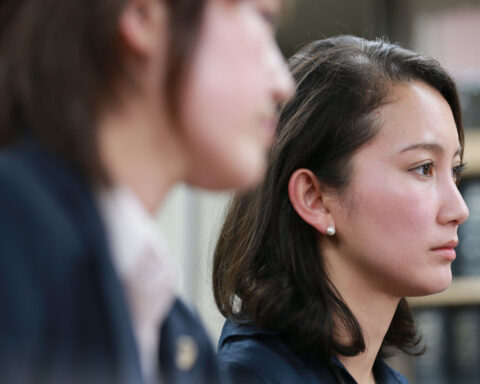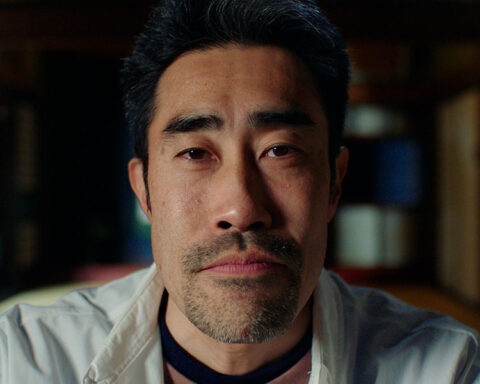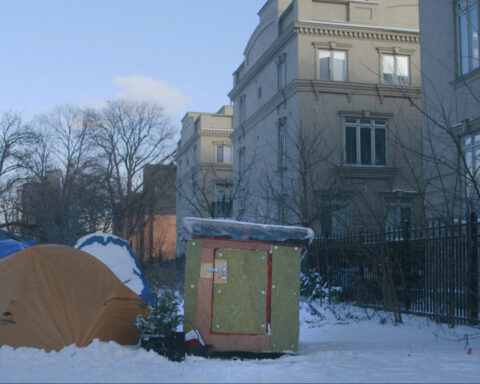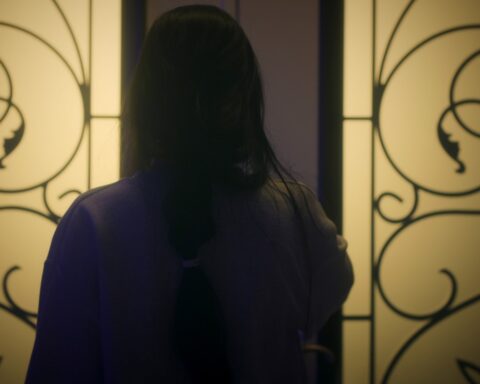Linda Ohama’s first feature-length documentary Obaachan’s Garden (2002) won five Leo Awards, including best director. Her latest film, Tohoku no Shingetsu: A New Moon Over Tohoku, about survivors of the 2011 tsunami and Fukushima nuclear disaster, is the Vancouver director’s tenth film project. Before making the documentary, Ohama spent a year and a half participating in relief efforts in Tohoku, the area in northeastern Japan devastated by the disaster. (The heroic Ohama also organised a fundraiser in Vancouver, which raised $250,000.) Filmed two years after the earthquake, A New Moon Over Tohoku, takes a raw, unfiltered look at the devastation and dead-slow recovery efforts to house hundred of thousands of homeless survivors. The project’s occasional lo-fi footage only gives more urgency to the horror of what we see and hear.
An article in The Bulletin (a journal published by Greater Vancouver Japanese Canadian Citizens’ Association) offers some insight into the making of the film.
“With no crew and no budget, Ohama learned to do a lot with very little. She estimates that she spent a total of five nights in a hotel over the two-and-a-half years she spent filming. The rest of the nights were spent on a futon in someone’s house, in a car, or in her small pup tent when there was nothing else. A low-point was sleeping in a kitchen sink for a month and she had no heat or refrigeration for months. The outside mailbox served as her fridge and everything froze half the time.”
While in Japan recently, Ohama, a mother and grandmother, wrote to POV about A New Moon Over Tohoku.
NL: Nancy Lanthier for POV
LO: Linda Ohama
NL: In the film, you say that you decided to make the documentary while walking around the Fukushima ghost town of Odaka.
LO: I never intended to make a film, only to volunteer in the recovery of Tohoku. But in my heart, I probably started making this film the second I arrived in Tohoku.
Seeing the destroyed communities, and hearing the voices of the Tohoku people whom I met—mothers, fathers, grandpas, grandmas, children, fishermen—plus the sounds I heard of non-stop dump trucks, cranes, heavy machinery, waves, the smells of decay, incense, flowers, dust: all of these things moved me as I traveled to villages along the destroyed coastline of Tohoku.
Even though I was not thinking of making a film at first, these first moments are important parts of the final film. They are like the meditation that led to feeling a deeper sense of what Tohoku and the people were experiencing. That’s the only way I can describe this phase of pre-making this film.
It’s like the ‘shingetsu’ (new moon that you can’t see in the night’s sky): You don’t always see the person in the film, or hear their voices, but they are still there. Their spirit is just as real and important as the people you see in the film.
And wherever I went, people asked me to help them tell their story to the Japanese outside of Tohoku, and to the world.
At first I always felt it was not my place to make their film. This feeling changed on my first trip into the ‘no go zone’ of Fukushima. Walking down the main street of one of these ghost towns is like being in a scary science fiction movie, where all life is taken away, and only memories stay behind. It was eerie and sad to see what mankind has created and destroyed. It just made me cry to see this.
It was here while crying that the filmmaker inside me came alive, and I decided to try to tell this story.
NL: What kept you motivated to work for two and a half years on the project, despite severely challenging filming conditions?
LO: The conditions under which I traveled in Tohoku were nothing compared to what the Tohoku people had to deal with. They were minor because the Tohoku people shared such kindness, that I fell in love with them.
Yes, it was challenging. Yes, sometimes uncomfortable. At one place, the whole town was wiped out and what remained was whatever was higher up the hills. The schools, the city hall, the defense forces, the emergency shelters all shared this one huge Sportsplex area.
Flies were thick because of all the decay. Disinfectant powder scattered, whitening the ground. Homemade plastic water-bottle flycatchers full of drowned flies hung everywhere.
Older and more needy people slept indoors on the floor of the gymnasium. Younger families with kids were given ‘survival’ dome shaped tents to make as their home for more than six months: One family with a few kids in each tent, with all their meager belongings like bedding, clothes, etc., packed inside. There was no space for kids to do their homework inside, so in the evenings I could see so many working alone outside their tent homes. There were so many flies and mosquitoes around them, as they sat on bare ground that was dusty when dry or muddy when it rained.
At this place, I was welcomed to pitch my pup tent amongst them instead of in the woods.
The Jeitai (Defence Force) set up two huge tent bathhouses: one for women and one for men. Japanese like to have their ‘ofuro’ hot bath every night; this is an important part of their tradition.
These common tent bathhouses were guarded and only for victims of the town, but the tent village mothers invited me in with them. What a special feeling to be soaking in the steaming hot water amongst the children and women. They could share this with me, and it brought me to tears as I listened to them sing to create some joy.
And in the early mornings, a truck arrived to deliver the breakfast. One small rice ball and one mini sized carton of milk per person. One family shared one whole rice ball with me! Left with nothing, these people could still be so gracious and welcoming with their generosity. That’s what it was like.
Yes, my pup tent was small and I couldn’t stand up to get changed, but the people always made me forget about the inconveniences: A person begins to appreciate life and people in a different way of being.
NL: The Japanese character is to keep feelings inside. Yet so many people opened up to you about their experience of the tsunami. Why?
LO: I don’t know why. Maybe because I look like I’m Japanese, but I am not Japanese, and considered a foreigner—so they don’t have to be so “culturally correct.” Maybe it’s because I don’t speak Japanese very well, so they think I can’t understand a lot of things that they could release in their talking. Maybe it’s because I am a woman traveling alone and volunteering alone in the disaster area—not with any organised volunteer group, but just me. Maybe it’s because I am a mother and grandmother myself and they could identify with me. Maybe it’s my natural character.
Maybe they were just happy to have company to talk to.
I am not certain of the answer. But I am certain that after visiting these people and places on multiple occasions during the filming we became close friends—even family.
NL: Some of the characters express how difficult it was to carry on living after the disaster and the film states suicide was a problem. Yet how is it that your film often shows hope and even joy?
LO: There is no simple answer to this question. I lost some good friends in Tohoku during those years. Some through freak accidents and others because they gave up. But, other friends have had babies or graduated from university, or gotten married. Life and death are a part of life anywhere…the conditions are just more extreme in a place like Tohoku, so life and death become more profound.
NL: Your film has a very personal, even at times lo-fi quality. It works. I felt like I was in the room. Is this cinematography style intended?
LO: I wish I could tell you that I was such a good filmmaker that I had every shot and every question well planned out. But that’s not the truth.
In fact, the shooting is poor probably because I am not a real cameraperson or sound person. But I learned along the way with the help of some of the pros that I have worked with in the past. I would often get notes from them of what to watch for, or if I was having technical difficulties, I’d email off a question to them. So, I had lots of excellent technical back up from Vancouver and Onomichi.
And it was a disaster area with very little left in many of the small villages and towns. So where do you shoot? Outdoors, the wind just sweeps through because there’s no windbreak from trees or buildings, so the camera is shaking and the sound is crackly.
And indoor shooting—space was rare, you took what you got: Sometimes a broom closet with a bit of background decoration, or in the confines of the refugee housing. In most cases, there was very little room to move the camera and whenever someone moved in the space, it made things shake.
Overall, I couldn’t think about the technicalities or style much. I just followed my intuition and trusted by gut feelings instead of questioning my skills. But this is nothing new. It’s my usual way to direct or make art. Sometimes it works, and other times it looks messy but it captures the emotions of the shared moment.
NL: Did you feel two earthquakes during the shoot? As a viewer, it seemed to happen twice.
LO: On camera, a few earthquakes happened. The one inside the ‘kura building’ was a bit frightening because the women I was interviewing became visibly worried and upset.
Off camera, a lot more earthquakes happened. One’s cell phone usually screams out an alarm about a minute before an earthquake happens.
So when you’re sitting in a restaurant and all these cell phone alarms go off, everyone looks at each other with the look in their eyes, is this it for us?
But there is no panic. The Japanese are so used to it. There are several earthquakes a day somewhere in this country. Most of them are, thankfully, very small ones.
The worst I experienced was in the middle of the night sleeping in my pup tent. I slept on a foam yoga mat. I heard this loud roar of big trucks coming closer in the distance but it was not the sound from trucks but from an earthquake rumbling. When it hit, the ground under my body was rolling and my body got tossed around a bit.
The only time I was scared was when I had heard there was an earthquake that shook the greater Vancouver area. Not able to get any news, I phoned my children, but all three didn’t answer. Then in those moments, I was scared.
NL: One of the characters says she wished she knew sooner about the radiation because she let her kids play outside. It seems crucial mistakes were made by authorities after the disaster and your film could be important in terms of awareness of this. Might this be an intention of the film?
LO: The intention is just to present the people’s voices and experiences as they lived it. Yes, there was lack of information, but it’s not my intention to tell the Japanese what they did wrong. I’m not so wise as that. It’s just an opportunity to learn what really happened at ground level in the lives of ordinary people who lived with it.











